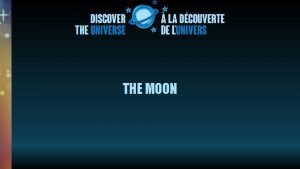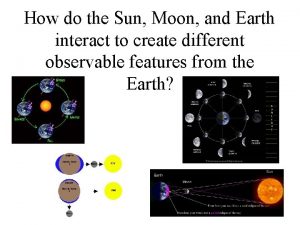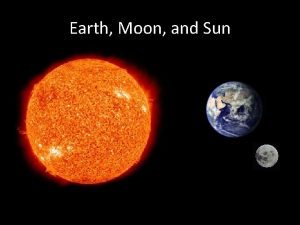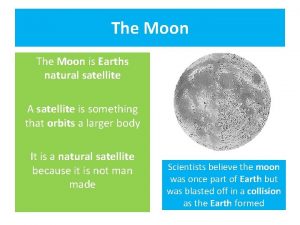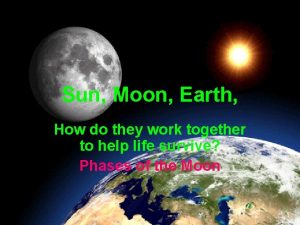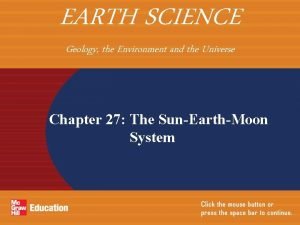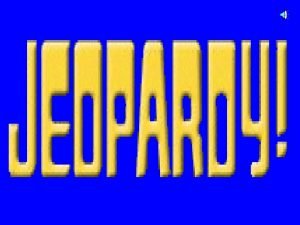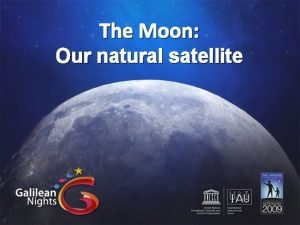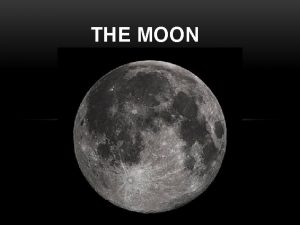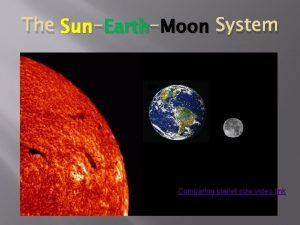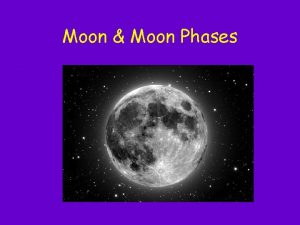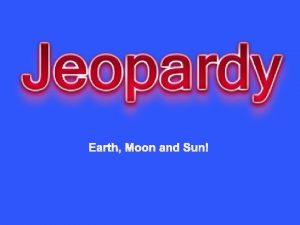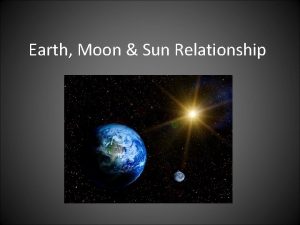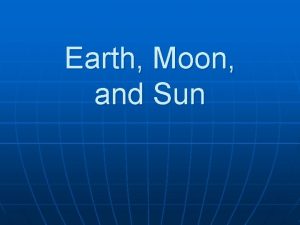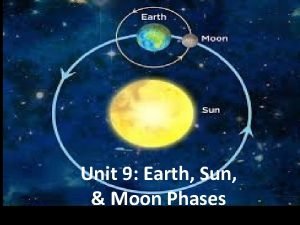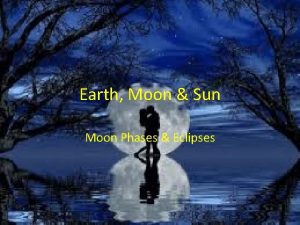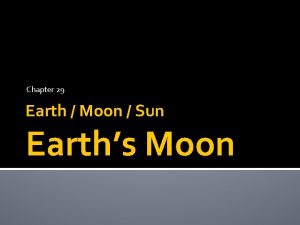Sun Earth and Moon The Sun The sun














- Slides: 14

Sun, Earth and Moon


The Sun The sun is an object in the sky made of very hot spinning gases. There are trillions of stars in space. The sun is one of those stars. The temperature of the Sun’s surface is 5500 degrees C. It produces its own heat and light. The sun is located in the center of our solar system. In fast, it is the only star in our solar system. The sun is classified as a medium-sized star. It appears larger than other stars because it is the closest star to Earth. The Sun’s strong pull of gravity keeps objects in our solar system in orbit. An orbit is the path an object takes around another object. Earth revolved, or travels, in its orbit around the Sun once each year. Each trip around the Sun is called a revolution. Record information about the Sun in your folded booklet after the class discussion.

Sun Characteristics ● ● ● ● Rotate on an axis Source of heat and light for our solar system Medium sized star Sphere of burning gas A million times bigger than the Earth No real surface Temperature on the surface is 5, 500 degree celcius


The Earth We live on the planet called Earth. It is the third planet from the Sun. Earth supplies the basic needs of living things- air, water, food and shelter. Earth is surrounded by a layer of gases called th atmosphere. Our atmosphere is a mixture of ● 78% Nitrogen, 21% Oxygen, and 1% carbon dioxide, water vapor and other gases The atmosphere of Earth supports our needs for oxygen in order to survive. About 70% of Earth’s surface is covered with water. Oceans hold about 97% of Earth’s water in the form of salt water. Only about 3% of EArth’s water is freshwater. Most freshwater is found in the form of glaciers, ice caps, and permanent snow.

The Earth Usable forms of freshwater on Earth’s surface are found in lakes, ponds, and rivers. You have already learned that the water on Earth is recycled through the processes of the water cycle. About 30% of Earth’s surface is land. The land is covered by a variety of landforms. A landform is a natural physical feature of Earth’s surface. Mountain, craters, plateaus, plains, and valleys are examples of landforms found on Earth. Record information about the Earth in your folded booklet after the class discussion.

Earth Characteristics ● ● ● ● 3 rd planet from the sun 4 times longer than the moon Rotates every 24 hours on an axis Has water and atmosphere LIFE- plants and living things Only planet to support life Sphere of rock


The Moon is Earth’s only natural satellite. A satellite is an object that travels around another object. It takes the Moon 27. 3 days to revolve around the Earth. The Moon is about one-fourth the size of Earth, and it is about 348, 000 Kilometers away. The Moon is made of rock. The rocky surface of the Moon has mountains, craters, flat areas and valleys. The craters formed when meteorites struck the surface of the Moon. Meteorites do not burn away before reading the Moon’s surface because the Moon does not have an atmosphere. Liquid water does not exist on the Moon, but there are small amounts of ice at the poles. Living organisms do not exist on the Moon because it does not have an atmosphere to sustain live. The temperature one the Moon can range from -160 degrees C to 100 degrees C.

The Moon You already know that. The Moon does not produce its own light. It reflects the light of the sun. The Moon appears to change its shape from night to night. The part of the Moon that we see depends on the positions of Earth, the Moon, and the Sun at that particular time. These changes in the Moon’s appearance are called the phases of the Moon, or the lunar cycle. Record information about the Earth in your folded booklet after the class discussion.

The Moon Neil Armstrong was the first man to walk on the Moon. Have you ever seen pictures of astronauts trying to walk on the Moon? The astronauts seem to bounce and float. What causes this? Gravity is a force that pulls objects toward each other. The more mass an object has, the greater its force of gravity. The gravity on the Moon is much less than on Earth because it has less mass than Earth. Since the gravity on the Moon is less than the gravity on Earth, astronauts weigh less on teh Moon. This is why they seem to float and bounce in Space. Record information about the Moon in your folded booklet after the class discussion.

Moon Characteristics ● ● ● ● Sphere or rock Rotates on an axis No atmosphere No life Surface scarred and cratered Natural satellite 29 days to revolve around the Earth Orbits the earth

Solar System
 Andreu cardo martinez
Andreu cardo martinez How does the moon earth and sun work together
How does the moon earth and sun work together How do the sun moon and earth interact
How do the sun moon and earth interact Sun earth
Sun earth Whats a natural satellite
Whats a natural satellite Earth moon sun relationship
Earth moon sun relationship How does the sun moon and earth work together
How does the sun moon and earth work together Lesson outline lesson 3 eclipses and tides answer key
Lesson outline lesson 3 eclipses and tides answer key Earth moon
Earth moon Which moon phase occurs directly before a new moon
Which moon phase occurs directly before a new moon Which moon phase occurs directly before a new moon
Which moon phase occurs directly before a new moon Moon sister moon calendar
Moon sister moon calendar Home.hiwaay.net/ krcool/astro/moon/moon tides/
Home.hiwaay.net/ krcool/astro/moon/moon tides/ Home.hiwaay.net/ krcool/astro/moon/moon tides/
Home.hiwaay.net/ krcool/astro/moon/moon tides/ Earth to sun size comparison
Earth to sun size comparison
